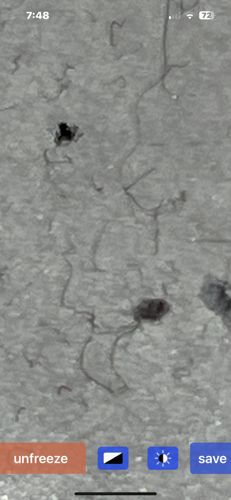Fungus Gnat Larvae, Bristle Millipedes (Polyxenidae)
Scientific Name: Sciaridae spp., Mycetophilidae spp. (Fungus Gnats); Polyxenus spp. (Bristle Millipedes)
Order & Family: Diptera (True Flies), Mycetophilidae / Sciaridae (Fungus Gnats); Polyxenida (Bristle Millipedes), Polyxenidae
Size: Fungus gnat larvae: 4-10 mm; Bristle millipedes: 1-5 mm. The structures in the image appear worm-like and segmented, fitting descriptions of both. The dark spots could be adult fungus gnats or debris.

Natural Habitat
Damp soil, rotting wood, leaf litter, decaying plant material, overwatered potted plants, greenhouses, and other moist environments with abundant organic matter. Bristle millipedes prefer similar damp, decaying habitats.
Diet & Feeding
Mainly decaying organic matter, fungi, algae, and microorganisms in damp environments for larvae. Adult fungus gnats do not typically feed.
Behavior Patterns
Larvae live within damp soil or decaying organic matter. They consume decaying vegetation, algae, fungi, and microorganisms. Some species may burrow into soft wood or plant stems. Adults are typically short-lived and focus on reproduction.
Risks & Benefits
Fungus gnat larvae can be minor pests in potted plants or nurseries by feeding on tender roots. They are largely harmless to humans. Bristle millipedes are generally considered beneficial as detritivores, breaking down organic matter. Neither are known to bite or carry diseases to humans.
Identified on: 8/29/2025